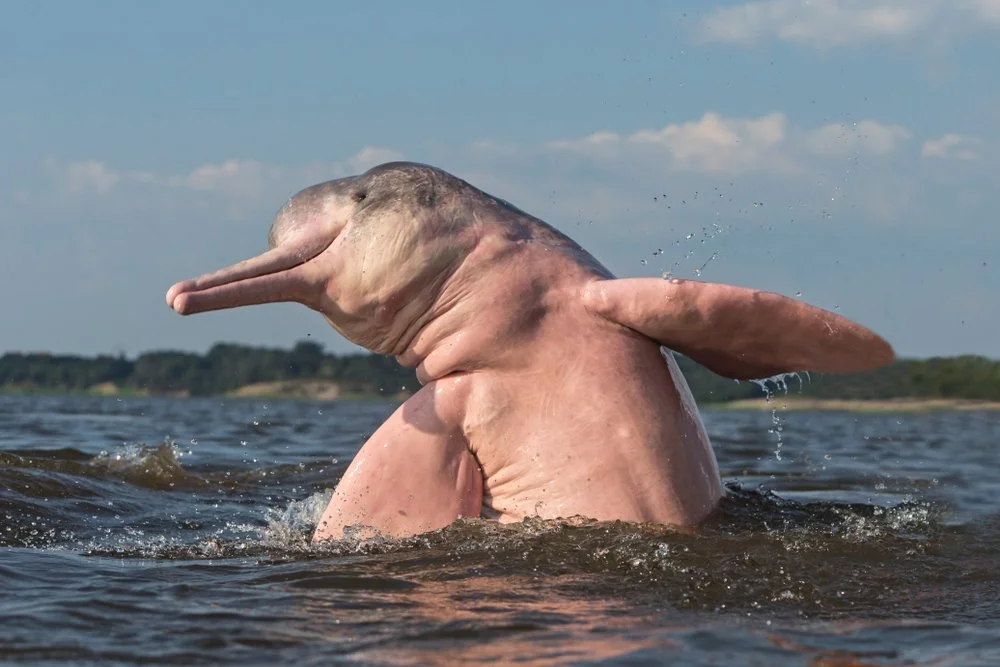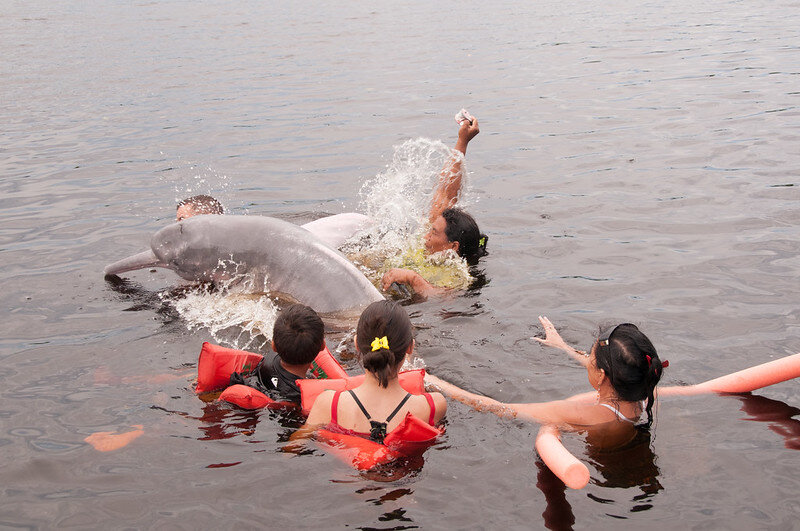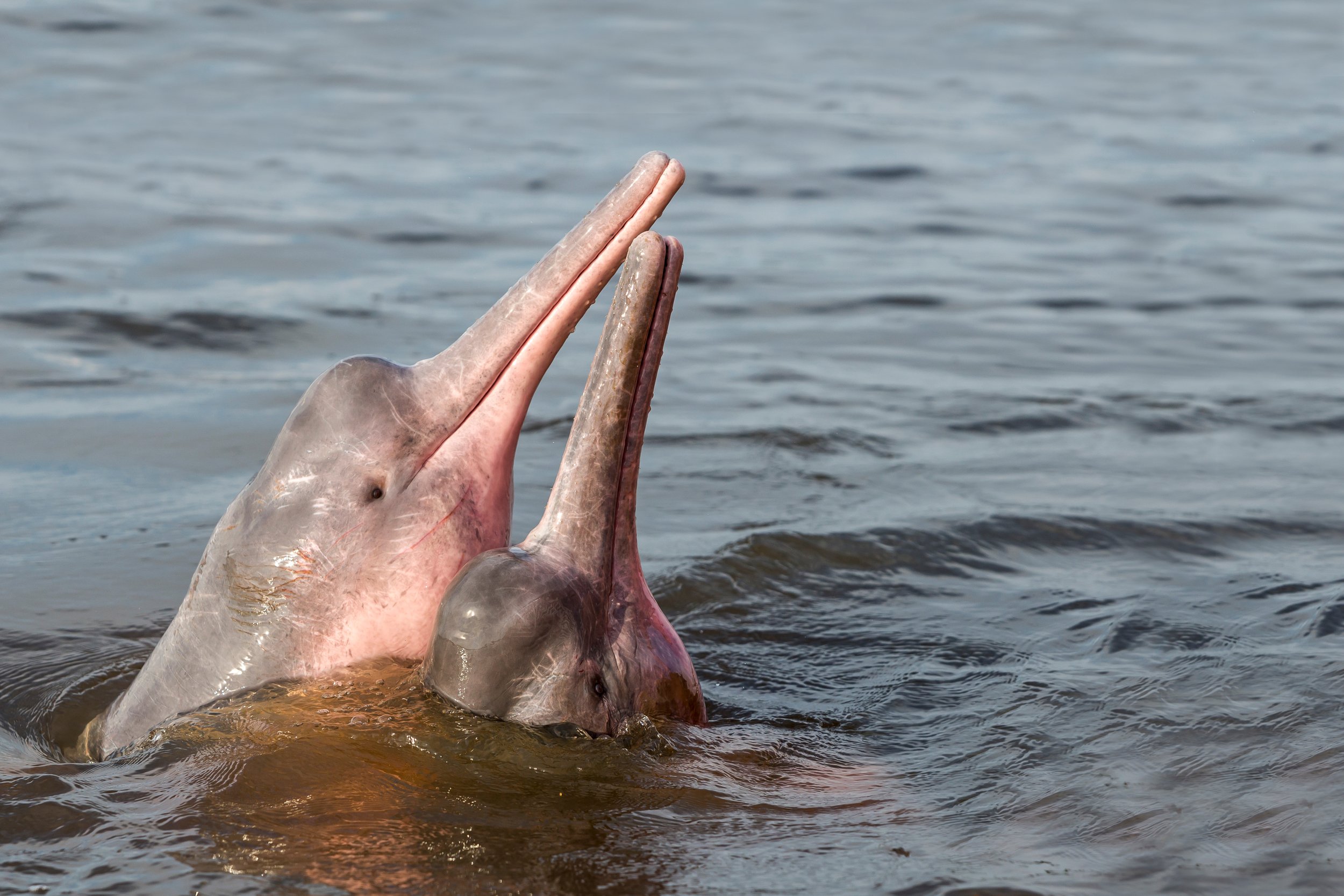Pink Dolphins: Your Guide to the Amazon River's Boto Dolphin
A greeting from a pink dolphin of the Amazon River.
You’ve heard about them, you might have seen a picture of a strange looking and slightly unbelievable animal, but are pink dolphins actually real? Discover the secrets of the pink dolphin, and learn more about why you may be running out of time to see them.
Are Pink Dolphins Real?
They are not a myth. Pink dolphins are very real. The pink dolphin, otherwise known as the Amazon River dolphin or boto, is an endangered species of dolphin famed for its bright appearance and unique body shape and colour.
Where Do Pink Dolphins Live?
The Amazon River dolphin can only be in the freshwater channels of the Amazon River and connecting Orinoco River in South America. The range of the pink dolphin spans much of their available freshwater habitat space, reaching from the eastern edge of Brazil all the way to Peru. Amazon River dolphins are distributed in these nations as well as Bolivia, Colombia, Ecuador and Venezuela. Wherever the Amazon and Orinoco Rivers reach.
Dolphins in Pink? Why Amazon River Are Dolphins Pink
Allen Sheffield from USA, CC BY 2.0
The Amazon River dolphin is not born with pink skin. Instead, these ‘pink dolphins’ are actually born with grey skin. Amazon River dolphin calves look very different when swimming side-by-side with their mother. So what makes these dolphins pink?
The pink hew of an Amazon River dolphin is actually caused by a variety of factors.
Putting the Pink in Pink Dolphin
The biggest influence on the colour of the pink dolphin is abrasions to the skin. Layers of grey are scratched away through a lifetime of swimming through the tight channels Amazon River, revealing a bright pink undertone. The result is that you can get mottled Amazon River dolphins with patches of both grey and pink, particularly in younger individuals. Males tend to be brighter shades of pink as they are more prone to fighting with each other to obtain a mate, causing high quantities of deeper abrasions to the skin and revealing that famous pink skin.
Ultimately, however, the shade of a pink dolphin’s skin is based on a number of elements, including their mood, diet, exposure to sunlight and location of blood vessels beneath the skin. For example: In warm waters, on a hot day, during strenuous, an Amazon River dolphin’s skin will be flush with blood, just as a humans would, leading to a much brighter shade of pink than if they were slowly drifting through cool rainy season waters.
What Do Pink Dolphins Eat?
The majority of the Amazon River dolphin’s diet consists of fish. However, they will eat crustaceans such as crabs which is thought to contribute to the pink hew of their skin, particularly those who eat higher numbers of shellfish.
Are Pink Dolphins Rare?
Amazon River dolphins can be difficult to spot if you’re looking in the wrong place. Looking in the right place, however, means you’re quite likely to catch a glimpse of the pink dolphin. While they navigate the murky waters of the Amazon River, they do still come up for air regularly as with all other dolphins, so if you’re visiting pink dolphin hotspots, sightings aren’t all that rare. In certain places, Amazon River dolphins are fairly abundant.
So where is the best place to see the Amazon River dolphin?
The Pacaya-Samiria Reserve is one of the best places to see pink dolphins in South America, and is located in the northern region of Peru. You can also travel to the Upper Amazon River, such as Rio Negro in Brazil.
How Many Pink Dolphins Are Left in the World?
We don’t actually know how many Amazon River dolphins exist in the wild. Given their extensive range and habitat, yet spotty distribution between hotspot locations, it’s very hard to put a figure on the pink dolphin population. It is estimated that there are well over ten thousand animals.
While this may sound like a lot, in 2018 the Amazon River dolphin was put on the red list of endangered species.
Why Are Pink Dolphins Endangered?
Photo by Michiel van Nimwegen - Credit Link - License
Since 2000, Amazon River dolphins numbers have decreased by an estimated 94%, based on population density studies.
Amazon River dolphins face a multitude of threats - all of which are caused by humans. Increasing human populations in South America, especially along the Amazon River and the Orinoco River, present many challenges that pink dolphins are not equipped to face.
Pollution is a major issue. Declining water quality effects Amazon River dolphin health. More specifically, pink dolphins are being harmed by mercury poisoning, a highly toxic chemical used in the illegal gold panning trade that is rife along the Amazon River. Other toxins are also present, and all combine in ways that can increase the chance of cancers and other serious health conditions in pink dolphins, as well as compromised immune systems and infertility.
Pink Dolphins Have More Problems
Overfishing is also a big problem for Amazon River dolphins. Humans are exhausting their supply of fish, making it impossible for the pink dolphin population to sustain itself. Boat strikes, accidental captures in fishing nets, intentional killings to keep pink dolphin away from fish stock, and destruction of habitat and their environment due to the installation dams along both rivers only compound to make the plight of the Amazon River dolphin ever more concerning.
These causes of population loss, however, are not the primary contributors to the decline of pink dolphins. The actual reason for their massive population reduction is far more disturbing and sinister.
Pink Dolphin Risks: Catfish & Amazon River Dolphin
Fishing for catfish is big business in Brazil. The giant fish fetch huge sums of money both on legal and illegal markets. But in 2014 Brazil put a ban on catfish fishing. Why?
For many years, fishermen have been using Amazon River dolphins as bait for catfish traps. The animals are large and full of meat. Fishermen poach the pink dolphin, set up a baited trap and collect vast numbers of catfish. The pink dolphin meat lasts a long time and attracts many catfish, resulting in very valuable hauls for the fishermen.
The practice was so successful that thousands upon thousands of Amazon River dolphins were slaughtered for use as catfish bait. Brazil placed a ban on the practice to help stem the flow of poaching Amazon River dolphins, and while it did help, the illegal killing of pink dolphins continued. Now the ban on catfish fishing has been lifted, and conservationists fear that we could see increasing numbers of pink dolphins harvested as catfish bait.
I’ve Heard the Pink Dolphin is Extinct
Pink dolphins are not extinct. Confusion here comes from there Yangtze River dolphin, once found in the Yangtze River of China, which was reported to have gone extinct in 2007. No animals have been seen since this time. The river dolphin name may be the cause of confusion as to why some people believe the Amazon River dolphin, or pink dolphin, may be extinct.
That is not to say there is no risk of extinction for the pink dolphins of the Amazon River. The threats faced by the Amazon River dolphin, such as pollution and declining fish stocks, are serious and could be disastrous if not properly managed.
Pink Dolphin Conservation: Can I Help Save the Pink Dolphin?
You can.
There are charities out working in the Amazon River right now, attempting to secure a future for the pink dolphin and fend off what is a very real chance of extinction.
The Amazon River Dolphin Conservation Foundation (ARDCF) has five key elements of conservation that make up their strategy to protect the Amazon River dolphin:
Pink Dolphin Research
This involves monitoring pink dolphin populations to create studies and reports used to influence government-backed Amazon River dolphin projects and programs.
Pink Dolphin Education Programs
The Amazon River Dolphin Conservation Foundation is out working with communities living across the Amazon River, educating them about the value of the pink dolphin for the ecosystem and helping them find new ways to earn money without slaughtering dolphins or conducting activities that destroy their fish stocks and their environment.
Dolphin Collaboration Projects
The pink dolphin-focused charity works closely with biologists, conservations, universities and others working in the same field, helping them to understand the Amazon River dolphin better, and supporting their goals to also protect these animals and influence both local communities and wider-scale institutional action.
Community Outreach
As part of their community work, the Amazon River Dolphin Conservation Foundation provides resources and supplies to communities living along the river, building relationships and offering them new ways of living that don’t involve pink dolphin harm.
Conservation of the Amazon River
The Amazon River dolphin is part of a much larger ecosystem. For the pink dolphins to thrive, the Amazon River must as well. The Amazon River Dolphin Conservation Foundation works to harmonise the ecosystem as a whole, supporting the dolphins habitat range and food chain.
Pink Dolphin Conservation: How to Get Involved
What can you do to be part of these efforts to protect the pink dolphins of the Amazon?
You can support the charity.
You can donate, you can follow their social accounts, you can spread the word of the pink dolphin and you can go on their guided expeditions (mentioned below). By getting involved in the fight to protect the Amazon River dolphin, you can do something very powerful: raise awareness. It’s much easier for animals to slip away into extinction when nobody is watching or waving the flag, trying to save them.
Be part of the conversation, share the message and you can make a real difference to the future of the Amazon River dolphin. As discussed in our article ‘How to Stop Poaching: Can You Make a Difference?’, you really can be part of the solution, even if you live half the world away.
Dolphin Spotting: How to See Amazon River Dolphins
The Amazon River Dolphin Conservation Foundation offers pink dolphin tours and trips for visitors to the Amazon River out of Manaus in Brazil, allowing you to get out on the water and view pink dolphins in the company of trained conservationists and Amazon River dolphin experts. We would highly recommend this experience if you’re interested in seeing pink dolphins in the wild. Taking trips with the Amazon River Dolphin Conservation Foundation helps support their pink dolphin funding drives and sustains their work within the region.
Alternative Pink Dolphin Trips
There are other options for pink river dolphin tours, but we cannot recommend any other specific organisations or tour groups as Xplore Our Planet is not aware of their stance on ethics or their conservation credentials towards pink dolphins of the Amazon. This does not mean there are no other trustworthy tour groups available, but research should be carried out before arranging any activities with other providers that take you out on the water to observe pink dolphins.
Always be mindful of risk humans pose to this species when viewing Amazon River dolphins, and don’t go with tour operators that encourage close encounters or touching the animals.
Are Pink Dolphins Dangerous?
Amazon River dolphins are not dangerous. Like most other dolphins, they are docile animals with no records of aggression towards humans. They can be aggressive towards each other, particularly during mating season as males compete for the affection of females, but people need not fear the Amazon River dolphin while out on viewing excursions or exploring the river.
Pink Dolphin Encounters: Can I Swim with Amazon River Dolphin?
Photo by uh whatever - Credit Link - License
While it is legal to swim with Amazon River dolphins across their range, we would strongly advise against any planned activity.
Many tourist operators will offer guaranteed swimming with dolphins and feeding opportunities. Anything that involves providing wild animals with food to bait them for entertainment diverges to them from their natural behaviours and causes a dangerous reliance on people for food and a decline in natural hunting abilities.
Pink Dolphins Encounters Can Be Dangerous - for the Dolphin
Pink dolphins are routinely held and corralled into tight spaces so tourists can pose for photos, which is not only physically harmful for Amazon River dolphins but also stressful. Close interaction with people also builds a dangerous familiarity, which can lead pink dolphins to approach situations that cause them harm, such as getting too close to boats and getting caught in propellers or nets.
All animal encounters in the wild should be passive experiences, whereby the animal is observed peacefully in their natural habitat without influence or disturbance. Bobbing up and down on the rippling surface of the Amazon River as pink dolphins move around in the distance is a passive experience, even if they do decide to get a little closer.
However…
Pink Dolphins Need a Choice
Standing on platforms on the shorelines of towns and villages, tempting animals in with fish and reward is not passive and should always be discouraged. It is not their choice to interact with you if they are being baited or handled.
Amazon River dolphins are endangered animals and need to be protected.
If you want to swim with dolphins, we have a guide that will help you do it ethically.
Pink Dolphins in Hong Kong, Thailand and Asia
The Amazon River dolphin is not the only pink dolphin. The Indo-pacific humpback dolphin can also appear to have a pink hew to its skin, sometimes this pink is found to be quite bright and vibrant. Their skin can also appear white or grey in colour.
When referring to pink dolphins, these are unlikely to be the dolphins up for discussion.
Why? It’s not exactly clear. It may be a simple case of notoriety for the pink dolphins of the Amazon, or perhaps that because they also appear in white and grey shades (sometimes referred to as the Chinese white dolphin) they haven’t picked up the same connection to the colour pink as the Amazon River dolphins.
Whatever the reason, these are still fascinating animals. You can hear all about them on the Marine Mammal Science podcast in a guest talk with Dr Thomas Jefferson (no affiliation).
Pink Dolphins Need Your Help
Act now, if you can, to help support the plight of the Amazon River dolphin.








